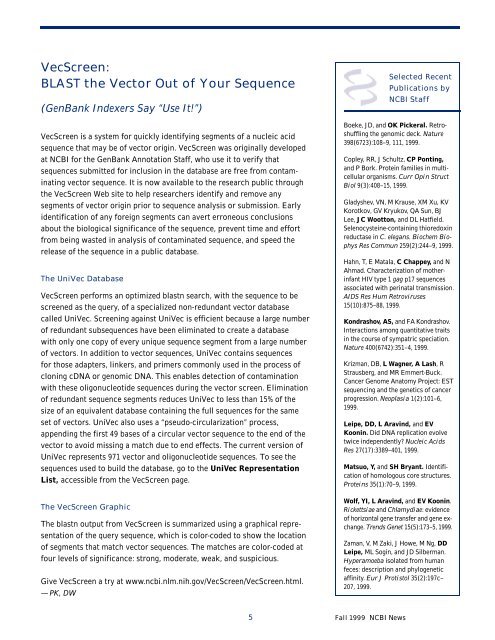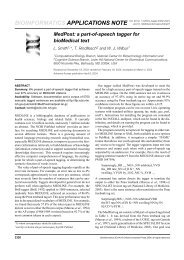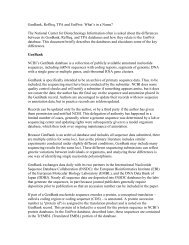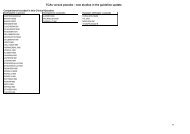Entrez Search Services Enhanced NCBI Home Page Redesigned
Entrez Search Services Enhanced NCBI Home Page Redesigned
Entrez Search Services Enhanced NCBI Home Page Redesigned
Create successful ePaper yourself
Turn your PDF publications into a flip-book with our unique Google optimized e-Paper software.
VecScreen:<br />
BLAST the Vector Out of Your Sequence<br />
(GenBank Indexers Say “Use It!”)<br />
VecScreen is a system for quickly identifying segments of a nucleic acid<br />
sequence that may be of vector origin. VecScreen was originally developed<br />
at <strong>NCBI</strong> for the GenBank Annotation Staff, who use it to verify that<br />
sequences submitted for inclusion in the database are free from contam-<br />
inating vector sequence. It is now available to the research public through<br />
the VecScreen Web site to help researchers identify and remove any<br />
segments of vector origin prior to sequence analysis or submission. Early<br />
identification of any foreign segments can avert erroneous conclusions<br />
about the biological significance of the sequence, prevent time and effort<br />
from being wasted in analysis of contaminated sequence, and speed the<br />
release of the sequence in a public database.<br />
The UniVec Database<br />
VecScreen performs an optimized blastn search, with the sequence to be<br />
screened as the query, of a specialized non-redundant vector database<br />
called UniVec. Screening against UniVec is efficient because a large number<br />
of redundant subsequences have been eliminated to create a database<br />
with only one copy of every unique sequence segment from a large number<br />
of vectors. In addition to vector sequences, UniVec contains sequences<br />
for those adapters, linkers, and primers commonly used in the process of<br />
cloning cDNA or genomic DNA. This enables detection of contamination<br />
with these oligonucleotide sequences during the vector screen. Elimination<br />
of redundant sequence segments reduces UniVec to less than 15% of the<br />
size of an equivalent database containing the full sequences for the same<br />
set of vectors. UniVec also uses a “pseudo-circularization” process,<br />
appending the first 49 bases of a circular vector sequence to the end of the<br />
vector to avoid missing a match due to end effects. The current version of<br />
UniVec represents 971 vector and oligonucleotide sequences. To see the<br />
sequences used to build the database, go to the UniVec Representation<br />
List, accessible from the VecScreen page.<br />
The VecScreen Graphic<br />
The blastn output from VecScreen is summarized using a graphical repre-<br />
sentation of the query sequence, which is color-coded to show the location<br />
of segments that match vector sequences. The matches are color-coded at<br />
four levels of significance: strong, moderate, weak, and suspicious.<br />
Give VecScreen a try at www.ncbi.nlm.nih.gov/VecScreen/VecScreen.html.<br />
— PK, DW<br />
5 Fall1999 <strong>NCBI</strong> News<br />
Selected Recent<br />
Publications by<br />
<strong>NCBI</strong> Staff<br />
Boeke, JD, and OK Pickeral. Retroshuffling<br />
the genomic deck. Nature<br />
398(6723):108–9, 111, 1999.<br />
Copley, RR, J Schultz, CP Ponting,<br />
and P Bork. Protein families in multicellular<br />
organisms. Curr Opin Struct<br />
Biol 9(3):408–15, 1999.<br />
Gladyshev, VN, M Krause, XM Xu, KV<br />
Korotkov, GV Kryukov, QA Sun, BJ<br />
Lee, JC Wootton, and DL Hatfield.<br />
Selenocysteine-containing thioredoxin<br />
reductase in C. elegans.Biochem Biophys<br />
Res Commun259(2):244–9, 1999.<br />
Hahn, T, E Matala, C Chappey, and N<br />
Ahmad. Characterization of motherinfant<br />
HIV type 1 gagp17 sequences<br />
associated with perinatal transmission.<br />
AIDS Res Hum Retroviruses<br />
15(10):875–88, 1999.<br />
Kondrashov, AS, and FA Kondrashov.<br />
Interactions among quantitative traits<br />
in the course of sympatric speciation.<br />
Nature 400(6742):351–4, 1999.<br />
Krizman, DB, L Wagner, A Lash, R<br />
Strausberg, and MR Emmert-Buck.<br />
Cancer Genome Anatomy Project: EST<br />
sequencing and the genetics of cancer<br />
progression. Neoplasia 1(2):101–6,<br />
1999.<br />
Leipe, DD, L Aravind, and EV<br />
Koonin. Did DNA replication evolve<br />
twice independently? Nucleic Acids<br />
Res 27(17):3389–401, 1999.<br />
Matsuo, Y, andSH Bryant. Identification<br />
of homologous core structures.<br />
Proteins35(1):70–9, 1999.<br />
Wolf, YI, L Aravind, andEV Koonin.<br />
Rickettsiaeand Chlamydiae: evidence<br />
of horizontal gene transfer and gene exchange.<br />
Trends Genet15(5):173–5, 1999.<br />
Zaman, V, M Zaki, J Howe, M Ng, DD<br />
Leipe, ML Sogin, and JD Silberman.<br />
Hyperamoeba isolated from human<br />
feces: description and phylogenetic<br />
affinity. Eur J Protistol 35(2):197c–<br />
207, 1999.





